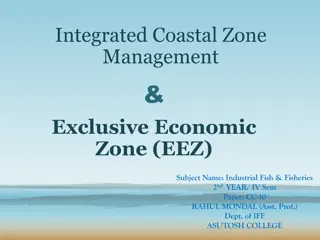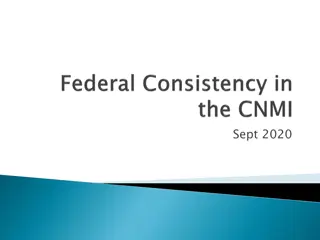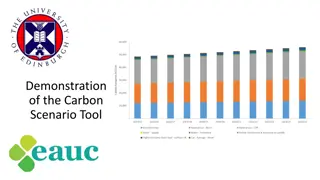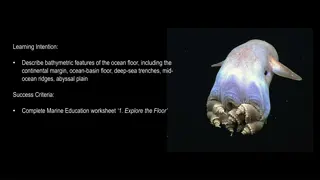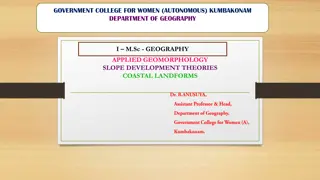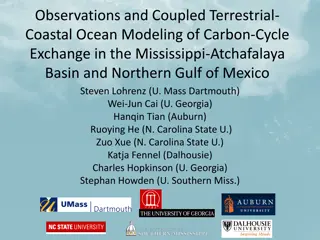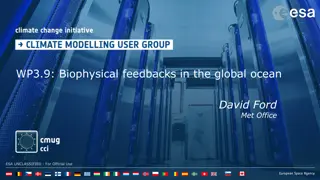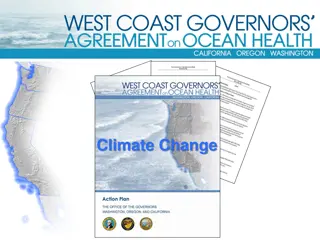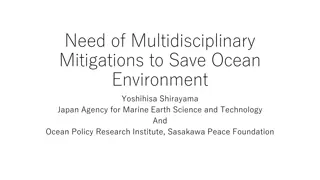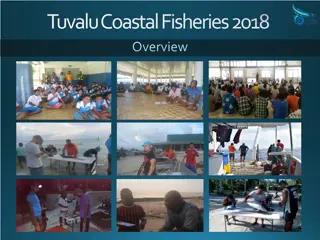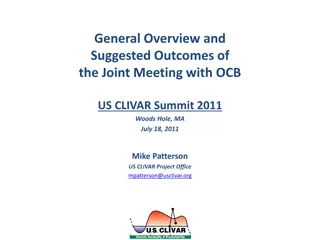Integrated Terrestrial-Coastal Ocean Framework for Carbon Management
An advanced framework integrating terrestrial and coastal ocean observations and modeling is developed to support carbon management decisions. The study focuses on assessing the impacts of land use, human activities, and climate scenarios on the carbon cycle, particularly dissolved inorganic carbon fluxes from the terrestrial to coastal ecosystems. Projected increases in dissolved inorganic carbon export highlight the need for effective carbon management strategies. Satellite-based approaches are utilized to expand spatial and temporal coverage of surface ocean pCO2 and sea-air CO2 flux in the northern Gulf of Mexico, providing valuable insights into seasonal and interannual variations in CO2 dynamics. The findings emphasize the significance of understanding human and climate influences on coastal carbon budgets.
Download Presentation

Please find below an Image/Link to download the presentation.
The content on the website is provided AS IS for your information and personal use only. It may not be sold, licensed, or shared on other websites without obtaining consent from the author. Download presentation by click this link. If you encounter any issues during the download, it is possible that the publisher has removed the file from their server.
E N D
Presentation Transcript
An Integrated Terrestrial-Coastal Ocean Observation and Modeling Framework for Carbon Management Decision Support Steven Lohrenz (U. Mass Dartmouth), Hanqin Tian (Auburn), Wei-Jun Cai (U. Del), Ruoying He (NCSU) Our project objectives include examining different land use/human activity scenarios within the terrestrial domain and different climate scenarios to assess impacts on the carbon cycle Dissolved inorganic carbon (DIC) is a major flux from the terrestrial to coastal ocean ecosystem (on the order of 0.4 Pg C y-1) and there is growing evidence that DIC fluxes are increasing Increased DIC fluxes in the Mississippi River basin have been attributed largely to human activity, but less is known about how future changes in climate will alter this DIC Export: +65% (A2) and +35% (B1) We used the Dynamic Land Ecosystem Model (DLEM) to project impacts of future changes in climate, atmospheric CO2, and land use on riverine DIC fluxes over the 21st Climate-related changes would dominate DIC export over the 21st century Annual DIC export is projected to increase by 65% under high emission scenario (A2) and 35% under low emission scenario (B1) during 2000s -2090s. The increasing DIC fluxes are likely to have profound impacts on carbon cycling in inland and coastal waters, and projections of such changes will be developed in our project through coupling the terrestrial outputs to a coastal ocean biogeochemical model The DLEM also provides spatially explicit descriptions of DIC processes that can support land use and carbon management efforts to mitigate potentially negative impacts Ren, W., H. Tian, B. Tao, J. Yang, S. Pan, W.-J. Cai, S. E. Lohrenz, R. He, and C. S. Hopkinson (2015), Large increase in dissolved inorganic carbon flux from the Mississippi River to Gulf of Mexico due to climatic and anthropogenic changes over the 21st century, Journal of Geophysical Research: Biogeosciences, 120(4), 724-736, doi:10.1002/2014jg002761. Supported by funding from the NASA Carbon Monitoring System Program (NX14AO73G)
Satellite estimation of coastal pCO2 and air-sea flux of carbon dioxide in the northern Gulf of Mexico Challenge: A contributing factor in uncertainties in coastal carbon fluxes stems from the under sampling of seasonality and spatial heterogeneity. Our objectives were to i) assess satellite-based approaches that would expand the spatial and temporal coverage of the surface ocean pCO2 and sea-air CO2 flux for the northern Gulf of Mexico, and ii) investigate the seasonal and interannual variations in CO2 dynamics and possible environmental drivers. Methods: Regression tree analysis was effective in directly relating surface ocean pCO2 to satellite-retrieved (MODIS Aqua) products including chlorophyll, sea surface temperature, and dissolved/detrital absorption. Satellite-based assessments of sea surface pCO2 were made spanning the period from 2006-2010 and were used in conjunction with estimates of wind fields and atmospheric pCO2 to produce regional-scale estimates of air-sea fluxes. Key Findings: Seasonality was evident in air-sea fluxes of CO2, with an estimated annual average CO2 flux for the study region of -4.3 + 1.1 Tg C y-1, confirming prior findings that the Gulf of Mexico was a net CO2 sink. Interannual variations in fluxes were evident and related to Mississippi River dissolved inorganic nitrogen (DIN) loading. Satellite-derived pCO2 image for April 2009. Satellite-based estimates of sea-to-air flux of CO2 (shaded areas represent plus or minus one standard deviation). The circle symbols are results from ship-based estimates. Arrow indicates strongest negative fluxes (ocean uptake) during March 2010. Annual CO2 flux (Tg C y-1) and DIN loading (Tg N y-1) for the region. Significance: This is the first multi-year assessment of pCO2 and air-sea flux of CO2 using satellite-derived environmental data for the northern Gulf of Mexico. Interannual variability in fluxes was related to Mississippi River DIN inputs, an indication that human- and climate- related changes in river exports will impact coastal carbon budgets. Supported by funding from NASA (NNX10AU06G, NNX12AP84G, NNX14AO73G, and NNH13ZDA001N) NASA Publication from NACP Projects Lohrenz-04, Lohrenz-05: Lohrenz, S. E., W.-J. Cai, S. Chakraborty, W.-J. Huang, X. Guo, R. He, Z. Xue, K. Fennel, S. Howden, and H. Tian (2018), Satellite estimation of coastal pCO2 and air-sea flux of carbon dioxide in the northern Gulf of Mexico, Remote Sensing of Environment, https://doi.org/10.1016/j.rse.2017.12.039
Modeling pCO2 variability in the Gulf of Mexico Challenge: Oceans act as receivers of large carbon loading from terrestrial run-off and as vast carbon reservoirs via the ocean carbon pump. Thus, a better understanding of the oceans role in regulating the global carbon cycle is crucial. Our objectives were to 1) produce model simulations of CO2 flux at the air sea interface in the Gulf of Mexico - current estimates are based largely on observational analyses and subject to large uncertainty; and 2) constrain the relationship between CO2 fluxes, river plume dynamics, and dominant oceanic processes. Methods: A three-dimensional coupled physical biogeochemical model was used to simulate and examine temporal and spatial variability of sea surface partial pressure of CO2 (pCO2) in the Gulf of Mexico. The model was driven by realistic atmospheric forcing and observed freshwater and terrestrial nutrient and carbon input from major rivers to produce a multi-year model hindcast (2005-2010). NASA and other satellite data (MODIS, AVISO) were used in the tuning and validation of the model (see also Xue et al., 2013, Biogeosciences, 10, 7219 7234). Key Findings: Model results revealed seasonality in surface pCO2 and showed that, despite spatial and temporal variability, the Gulf of Mexico was a net CO2 sink, with a flux of 1.11 + 0.84 x 1012 mol C yr-1. This is comparable to estimated inorganic carbon export through the Loop Current. Model simulated time-series of spatially averaged pCO2 in the Gulf of Mexico, overlaid with in situ observations (in black). Control run (in blue) included all processes, and no-biology run (in magenta) included only physical and chemical effects. Significance: This is the first comprehensive physical-biogeochemical coupled model simulation of air-sea flux of CO2 in the Gulf of Mexico. The findings highlight the role of biological uptake as an important driver for the CO2 sink and provide critical information for North American and global carbon budgets. Six-year (2005 2010) model mean air sea CO2 flux in the Gulf of Mexico during spring. Blue indicates ocean is a sink for CO2; red a source. Supported by funding from NASA (NNX10AU06G, NNX12AP84G, NNX14AO73G, and NNH13ZDA001N) NASA Publication from NACP Projects Lohrenz-04, Lohrenz-05: Xue, Z., He, R., Fennel, K., Cai, W.J., Lohrenz, S., Huang, W.J., Tian, H., Ren, W., & Zang, Z. (2016). Modeling pCO2 variability in the Gulf of Mexico. Biogeosciences, 13, 4359-4377.
Century-long increasing trend and variability of dissolved organic carbon export from the Mississippi River basin Background: There has been considerable debate as to how natural forcing and anthropogenic activities alter the timing and magnitude of the delivery of dissolved organic carbon (DOC) to the coastal ocean. The objective of this work is to quantify DOC export from the Mississippi River to the Gulf of Mexico during 1901 2010 as influenced by changes in climate, land use and management practices, atmospheric CO2, and nitrogen deposition. Method: We integrated ground- and satellite observations and historical data with the Dynamic Land Ecosystem Model (DLEM) to provide daily, spatially explicit estimates of carbon, nitrogen, and water fluxes from land to river and coastal ocean. Model- simulated DOC export is evaluated against observations from USGS gauging stations, and empirical estimates. Ten numerical experiments were designed to attribute DOC export to various driving factors. Key findings: 1. Significant, long-term increases in both DOC concentration and export were found during 1901 2010. Mean annual export of DOC averaged over decadal intervals increased by over 40% from 1.8 0.3 Tg C yr-1 in the 1900s to 2.6 0.4 Tg C yr-1 in the 2000s. DOC concentrations in the estuary increased by approximately 70% over the study period. 2. Land management was responsible for 43% of the long-term increase in DOC export, while land conversion contributed another 33%. Land use and land management were the dominant contributors to the century-scale trend of rising total riverine DOC export. The changes in CO2 concentration, Ndep, and Climate increased DOC export by 25%, 18%, and 9%, respectively. Significance: This is the first quantification of century-scale DOC export from the Mississippi river basin. And the changing trend of DOC was attributed to multiple anthropogenic and natural factors, which could provide useful information for designing mitigation strategies to reduce DOC export. This study was supported by NASA Carbon Monitoring System and Interdisciplinary Science Programs (NX14AO73G and NNX12AP84G). Changes in (a) annual DOC export and (b) decadal mean DOC export induced by climate change (Climate), atmospheric CO2, nitrogen deposition (Ndep), land cover change (LC), and land management (LMPs). Ren, W., H. Tian, W.-J. Cai, S. E. Lohrenz, C. S. Hopkinson, W.-J. Huang, J. Yang, B. Tao, S. Pan, and R. He (2016), Global Biogeochemical Cycles, 30(9), 1288-1299, doi:10.1002/2016GB005395.
Anthropogenic and climatic influences on carbon fluxes from eastern North America to the Atlantic Ocean Objectives: The magnitude, spatiotemporal patterns, and controls of carbon flux from land to the ocean remain highly uncertain. Here we applied a process-based land model (DLEM) with explicit representation of carbon processes in streams and rivers to examine how changes in climate, land conversion, management practices, atmospheric CO2 , and nitrogen deposition affected carbon fluxes including dissolved organic carbon (DOC), particulate organic carbon (POC), and dissolved inorganic carbon (DIC) from eastern North America to the Atlantic Ocean, specifically the Gulf of Maine (GOM), Middle Atlantic Bight (MAB), and South Atlantic Bight (SAB) during 1901-2008. Key Results: Magnitudes: The mean annual fluxes of DOC, POC, and DIC during 1980 2008 were 2.37 0.60, 1.06 0.20, and 3.57 0.72 Tg C /yr, respectively. Temporal Patterns: For the entire region from 1901 to 2008, riverine DIC fluxes significantly decreased and there were no significant trends in DOC or POC fluxes. Regional patterns: In the SAB, there were significant declines in the fluxes of all three forms of carbon, and in the MAB, DIC and POC fluxes declined significantly. The only significant trend in the GOM subregion was an increase in DIC flux. Attribution: Land conversion from cropland to forest was the primary factor contributing to decreases in all forms of C export, while nitrogen deposition and fertilizer use, as well as atmospheric CO2 increases, tended to increase DOC, POC, and DIC fluxes. Carbon dynamics and nutrient cycling along the land-aquatic interface in Dynamic Land Ecosystem Model (DLEM) Tian, H., Q. Yang, R. G. Najjar, W. Ren, M. A. M. Friedrichs, C. S. Hopkinson, and S. Pan (2015), Journal of Geophysical Research: Biogeosciences, 120(4), 757-772, doi:10.1002/2014JG002760. . Supported by funding from NASA Interdisciplinary Science Program (NNX11AD47G; NNX14AF93G) and Carbon Monitoring System Program (NX14AO73G)





